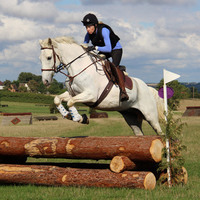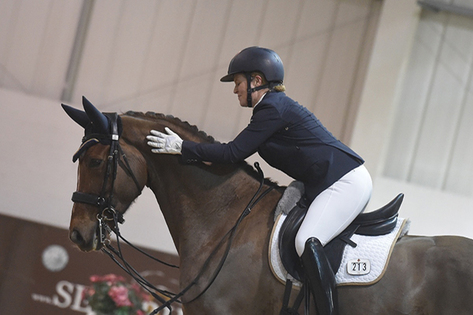
Are You & Your Horse Ready For Bitting Advice? The Steps You Need To Consider First
Equestrian Advice & Guides All Disciplines
Build your business profile for FREE and expose your services to thousands of potential clients!
Create my profile now!
Have you ever wanted to ride down the centre line on your beloved horse to show the judge what you’re capable of, but have felt intimidated by the flashy warmbloods in the warm-up? Do you ever think ‘what’s the point’ competing my genuine all-rounder against the horses bred to impress in the dressage arena? I know I have. So to find out if it’s really possible to realise our dressage dreams on our ‘ordinary’ horses, I met up with Irish international dressage rider, Laragh Osman.
Let’s be clear. Laragh’s two horses are far from ordinary – 15 year old ‘Ratti’ is competing at Inter 2, and in training for their first Grand Prix later this year. 7 year old 'Red' is training at Elementary and Medium and Laragh’s hoping to take him up the levels to Grand Prix too. Essentially, Laragh hopes to go as far as it’s possible to go in the sport.

With an impressive competition record, and a great deal of experience under her belt, I ask how far grass roots riders can realistically go on the dressage circuit. “There’s no point in pretending that you can get to the very top levels of dressage without a talented horse. They need to have physical soundness and trainability. In reality they are largely going to be well bred, and often quite quirky horses to reach the top. But there’s a massive space below that for the next tier of talented and great horses with super riders”.
“And the biggest part of it is the grass roots…the majority of members that make up British Dressage…are amateur riders with ‘ordinary-ish’ horses”. Let’s face it, we all know there’s no such thing as an ‘ordinary horse’.
So what kind of horse do we need to succeed? “I think you really just need a nice temperament, with a trainable brain, and three basic good paces. They must have a good true walk, a decent trot and a nice quality canter. The quality you’re looking for in an international horse isn’t necessarily at all the same as what you’d be looking for in a nice ordinary horse for someone to take up the levels. That could be a Welsh Section D, a Connemara, an Irish Sport Horse…”
 This is all very encouraging, but what are the limitations? “I’m not saying an ordinary horse can’t get to Grand Prix, because that’s not true. Ordinary horses could and can, I’m simply saying the odds are slightly stacked against you because of the limitations on the physical capability”.
This is all very encouraging, but what are the limitations? “I’m not saying an ordinary horse can’t get to Grand Prix, because that’s not true. Ordinary horses could and can, I’m simply saying the odds are slightly stacked against you because of the limitations on the physical capability”.
“Horses have to be able to cope with learning, and some horses struggle, like people, their attention span isn’t good enough. The key is steady, systematic training and soundness. A lot of horses with the best will in the world just don’t stay sound through the level of work that you need to do to climb up the levels. And also physical attributes; a successful dressage horse needs to be able to collect, sit back and carry its weight over its hind legs, and that puts different stresses onto their bodies that some are not necessarily born or bred to go that way naturally. A horse naturally in the wild carries more of its weight on its forehand and we’re training them to sit back, to lighten the forehand and carry more weight behind in the powerhouse”. “But good training, variety, mixing hacking and schooling and all these things help with the longevity of keeping these horses sound and in work”.
What would you say to the person who’s thinking ‘I can’t take my crossbreed into the warm up next to a flamboyant diva’? Laragh’s emphatic in her answer, “Do it! Train, and do it. Because the person on the flashy warmblood might not be able to get into the arena that day, their horse might not go anywhere near F, for example, and your slightly more ordinary horse is happy to trot around past F, and isn’t bothered by the flowers”.
“Do it, because there is enough in dressage for every level. The unaffiliated circuit is great, there’s My Quest and Team Quest now, there’re classes for natives, there’re classes for Spanish bred horses, and BD have really tried to break it up to enable there to be something for everybody”.
 Drawing on your own experience, what’s your advice for helping us to realise our dressage dreams? “Training, training, training. They always say you should spend less on the horse and more on the training, and you’ll go much further than spending lots of money on a horse and not having enough money left for the training. And that’s probably the biggest thing”.
Drawing on your own experience, what’s your advice for helping us to realise our dressage dreams? “Training, training, training. They always say you should spend less on the horse and more on the training, and you’ll go much further than spending lots of money on a horse and not having enough money left for the training. And that’s probably the biggest thing”.
“The best thing you can do is to find the best trainer you can afford, somebody that you can ideally see reasonably regularly in person, and if you find someone that you’re lucky enough to develop a good rapport with, then you’ve got to commit to a reasonably long term training goal”.
“So the key to success is, commitment, wanting to do it, and deciding that’s what you’re going to do. And a good trainer! Correct paces (not flash), decent conformation, consistent training and commitment”.
 What advice can you give to someone with an ‘ordinary’ horse who would like to give dressage a try? “Again, do it! Don’t give up. There’s something for everyone in this sport. You can’t compare yourself to people who do it all the time. You’re going to go into the ring with somebody riding their 4 year old superstar of the future, and you might be on Joey the cob, you might be sitting somewhere in the middle, you have to go on your own journey with it. But there’s no reason to not do it”.
What advice can you give to someone with an ‘ordinary’ horse who would like to give dressage a try? “Again, do it! Don’t give up. There’s something for everyone in this sport. You can’t compare yourself to people who do it all the time. You’re going to go into the ring with somebody riding their 4 year old superstar of the future, and you might be on Joey the cob, you might be sitting somewhere in the middle, you have to go on your own journey with it. But there’s no reason to not do it”.
“I think we all imagine there are 20 Valegros trotting around you as you’re in your warm up. It’s absolutely not the case. Go around all the different shows up and down the country and you see the huge variety of people who are out there, just enjoying their horses and trying to improve. You’d be amazed.”
Well I’m convinced. When the shows re-open, I’ll be dusting off my dressage tests, plaiting up my extraordinary, and much-loved ‘ordinary’ horse, and giving dressage competition a try…will you?
Follow Laragh Osman on Instagram > https://www.instagram.com/laraghosman.dressage/

